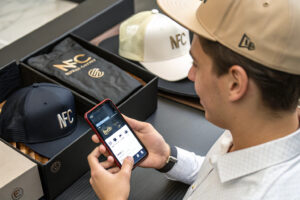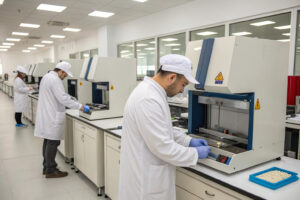When Ron, a U.S. buyer, orders thousands of hats from China, the last thing he wants is for the colors to bleed, fade, or shift after just a few wears or washes. Yet, in the world of custom-dyed hats, this risk is real—especially without the right supplier and quality control systems.
To ensure colorfastness in every hat we deliver, we at Global-Caps take a scientific, lab-verified approach—helping buyers like Ron avoid returns, maintain brand reputation, and keep customers happy.
Without strong colorfastness protocols, even beautifully designed hats can become customer complaints. That’s why understanding how dyes are tested, verified, and stabilized across materials matters so much. Let’s break down what buyers need to know.
What causes color fading in hats and how to prevent it?
Fading hats are more than a cosmetic issue—they signal weak dye chemistry or poor processing. Whether from sunlight, sweat, or friction, color degradation erodes your product value.
Colorfastness issues in hats often stem from substandard dyes, unoptimized fabric blends, or lack of post-dye fixation. Preventing fading starts with material preparation and lab-grade testing.

How do different fabrics affect dye performance?
Each material holds dye differently. For example, polyester needs disperse dyes with high-temperature application, while cotton uses reactive or direct dyes. Blends introduce even more complexity.
At Global-Caps, our CNAS-certified lab tests over 12 base fabrics with various dye types, simulating lightfastness conditions and wash resistance. These simulations help us preempt fading before mass production even begins.
What are the top 3 causes of poor color retention?
- Incorrect dye-to-fiber compatibility
- Skipping after-treatment like soaping or neutralizing
- Exposure to UV without stabilizers
Our factory partners mitigate these with post-dye chemical stabilizers, internal UV-testing, and pH-neutralizing baths that prevent dye migration.
What are the key colorfastness tests for hats?
While most buyers focus on visual samples, lab testing ensures repeatability. Key international colorfastness standards determine if your hat will survive outdoor wear, rain, or sweat.
Essential tests include ISO 105-B02 (light), AATCC 61 (wash), and AATCC 15 (perspiration). Each method mimics real-life stress—ensuring your hat color stays stable in tough conditions.

How is lightfastness evaluated for outdoor hats?
We test outdoor hats under simulated sunlight (ISO 105-B02). In our CNAS lab, hats rotate in a chamber for up to 72 hours under UV light, measuring changes against blue wool references. A score of Grade 4-5 is often the minimum we recommend for sunny regions like California or Arizona.
Our process is similar to SGS UV testing and includes pre-conditioning the fabric to mimic outdoor use.
How do you simulate washing and sweat exposure?
Using AATCC 61, we simulate 5–10 wash cycles at 40°C with synthetic detergent and evaluate staining and color change. For sweat, we use the AATCC 15 test, replicating both acidic and alkaline perspiration for 6 hours at 37°C.
Our lab-grade rub test (crocking test) also simulates abrasion from skin or surfaces—this is vital for snapbacks or fedoras worn daily.
How do you maintain color accuracy across batches?
Maintaining consistent hat color across thousands of units requires precision systems. Dyes are sensitive to water pH, temperature, and even humidity in the factory environment.
We standardize dye recipes and measure every bulk lot using spectrophotometers to match Delta E <1.0 vs approved samples. This means each hat looks consistent, batch after batch.

What’s the role of lab dips and Pantone matching?
Lab dips are pre-dye fabric samples that simulate the final result. Our clients often send us Pantone codes or physical swatches. We run 2–3 lab dips, scan them via Datacolor 650, and send digital reports alongside physical samples.
Once approved, this becomes the “master reference.” We log all dye formula parameters into our system so that even a new batch 6 months later matches precisely.
How does AI help with color control?
AI tools like SpectraVision analyze fabric texture and structure, ensuring dye penetration evenness. We integrate this with our smart dye kitchens to adjust recipe ratios in real time based on humidity or temperature changes.
This helps us maintain color evenness in challenging fabrics like velvet or mixed-fiber knits—popular in streetwear and seasonal capsule collections.
What questions should you ask your supplier?
Too often, buyers skip over the technical talk and focus only on pricing. Yet, asking the right questions about dye control can prevent major headaches later.
Buyers should request lab test reports, ask for past QC colorfastness rates, and confirm dyeing partnerships. These details can save thousands in lost stock or returns.

Can you see past lab reports before ordering?
Absolutely. We share real ISO 105 test reports for similar fabrics upon request. This helps buyers assess expected performance before placing a bulk PO. Our QR-linked system even lets you scan a sample and instantly download its test data.
Buyers should always verify if suppliers use in-house labs or outsource to certified third parties like SGS or Intertek. This matters for transparency and reliability.
What backup plans are in place for failed tests?
We always develop 2–3 dye recipes per project as backups. If a test fails, we switch to the next formula without delaying timelines. This is critical during tight promotional campaigns, where delays are costly.
Clients can also request a pre-production pilot batch, letting them test a small volume under market conditions before committing to full production.
Conclusion
Colorfastness isn’t just a quality metric—it’s your brand’s visual reputation. For buyers sourcing hats from China, asking for lab validation, standard tests, and batch control is essential. At Global-Caps, we ensure that every dyed hat delivers on color performance, batch consistency, and long-term durability. That’s how we help you win loyalty from first-time buyers to long-term fans.







